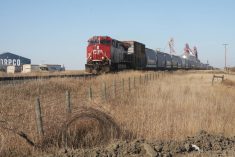After driving a Ram with the Cummins HO diesel and automatic transmission, I have a hard time figuring out why anyone would opt for the gas engine in a 2500 or 3500 series, even if the engine is a Hemi.
The truck I drove was a 3500 series long box with all the toys including trailer-towing mirrors. It took place during Test Fest at the Shannonville Motorsport Park in Ontario.
The Automobile Journalist’s Association of Canada had brought together all the new or significantly different vehicles sold in Canada this year so the Canadian car and truck of the year could be selected.
Read Also

Agriculture needs to prepare for government spending cuts
As government makes necessary cuts to spending, what can be reduced or restructured in the budgets for agriculture?
My first impression of the Ram was: this is huge and it needs running boards.
With four doors, full carpet and leather interior, the unit didn’t seem like a work truck, but the Dodge rep said the easy to clean leather seats are a popular option.
Front seat comfort was rounded out with the 40-20-40 split seat and a centre console that could be used as a portable office or a middle seat.
Our testing took us to an off-road course laid out for the occasion and the 3500 Ram did well until the part where it had to go down a “cottage trail.”
Those darn trailer towing mirrors kept getting in the way and eventually one writer forgot to fold them in a tight spot and broke one on a tree. Hitting the tree didn’t break it off. It broke when it hit the side window. The journalist couldn’t remember how fast he was going when this happened.
On the other trails, the Ram did well in four- and two-wheel drive. Its biggest handicap was that it was being compared with trucks considerably shorter, but it went over the rocks and logs and through the quarry in more comfort than most of the others.
For the first time in eight years, the bottom of the quarry had water – slightly less than waist deep, but more than mid-thigh.
The downhill compression test ramp went right to the bottom.
The Ram’s air intake is up high so getting water in was never a concern. Our slow speed was to avoid having water pile up in front of the rad and maybe pushing it out of its rubber mounts.
The interior got wet, but no more than it would after a day in the rain. I thought it was good, but the factory rep thought any moisture was unacceptable.
On the road, the Ram did much better. Acceleration was brisk and when I hit passing gear, the truck shot ahead. Getting people to move out of the fast lane so I could go by seemed fairly easy. The Ram looks intimidating and people had a tendency to get out of the way.
Ride quality when empty was surprisingly good. Small bumps and road irregularities could be felt, but were not bothersome. Large holes on some rural roads made the tail step out a bit if I didn’t slow down.
The last part of our test was a combination of road speed collision avoidance moves and a handling course for mid- and high-speed corners that simulate regular curves in the road, on and off ramps and braking. Here, the Ram felt comfortable and could generate numbers as good as some of the cars.
This gave me an idea. No one had ever taken a Ram 3500 on an open race track at our tests.
I talked the rep into getting back in for “brake and acceleration evaluations.” I promised him he would be surprised at the results.
First came the burn out. It started accidentally, but once the wheels broke loose – no traction control, just a limited slip differential – I kept my foot in it until we hit second gear and then I feathered the throttle to get us moving.
On the track there was a gentle curve and then 200 metres straight to a 90 degree right. Before I had to go for the brakes I had the truck up to 140 km-h and went through the corner at about 90 km-h. Two laps later, we were gaining on some of the cars and my rep figured it was time to stop. He was surprised by the truck’s performance.
This brings us to the issue of maintenance. What I was doing looked abusive, but was easier on the engine than running loaded at -40 C, or for that matter 40 C above. With regular servicing, the life-to-overhaul interval should be 560,000 km.
Charles Renny is a freelance automotive columnist and a member of the Automobile Journalists Association of Canada. The opinions expressed in this column are the personal views of the writer.
















